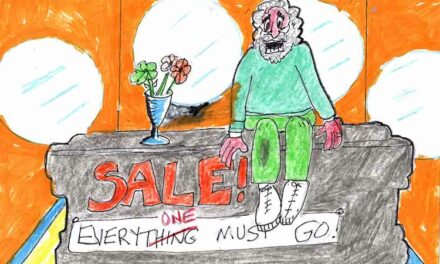“You Say Blue Wall, I Say Green Wall…”
Mediocre magic lives!
By Ed Goldman
Stephen Colbert did a screamingly funny pantomime on his Late Show recently. He pretended to be a TV weathercaster making sweeping, welcoming, even flirtatious gestures with vivid illustrations of wind currents and gusts, rain storms and snow flurries—without any visuals of those conditions behind him, as though the special effects team had taken the night off.
I’m sure you know that when weather reporters scare or reassure us of what to expect, and we see graphics of those conditions appear behind them on screen, these on-air folks are looking at an off-camera monitor to see what’s being projected behind them from the station’s control room. They’re making a fuss in front of a studio wall painted blue or green, which allows the crew to paste in the images for us at home.
Making new friends
You may be familiar with this process, alternately known as green-wall or blue-wall, from watching movies and TV shows, especially if they feature monsters, surrealistic landscapes or even actors playing two roles and interacting with themselves (which I believe is considered illegal in several of our redder states). But it doesn’t have to be anything as fanciful or elaborate as those examples for the colored walls to be called to action. They’re used to depict the background when actors are supposedly driving in a car, flying in a plane and sometimes, just sitting in the living room of a big-city apartment (i.e., the skyline view outside their windows exists on a video editor’s computer, where it’ll be inserted in the aptly named post-production process).
As recently as 20 years ago, producers had to rely on rear-screen projection to achieve these effects. This consisted of just what it sounds like: a still or moving image was displayed on a near-transparent screen behind the actors, who could actually turn around and see what was behind them. I imagine this helped their creative “process,” as they like to call it, since if you can see you’re supposed to be driving down the Champs-Élysées, everyone’s favorite Parisian thoroughfare, it’s probably a lot more helpful than, these days, standing in front of a blank blue or green wall and imagining you’re about to be attacked by a creature possibly still being designed by the CGI (computer-generated imagery) crew.
These days, if you participate in a Zoom call with people who want you to believe they’re in a nightclub in New Orleans, on a rocky cliff in Mendocino or even in a book-filled study in their own home, you already know the rudiments of fake scenery.
The Zoom foolers don’t even have to have a green- or blue-wall setup in, say, their laundry room. Their home computer lets them select their background—or, if they’re amateur shutterbugs and want to put up pix of vistas, monuments or puppies they personally photographed, that also can work.
But if you try this at home, be advised that the illusion is shattered if you move abruptly or lean into a certain portion of the screen: the visual results, which can include momentary faux-decapitation, can be horrifying to the family, friends, co-workers or job interviewers watching your “show.”
I know an attorney who loved advertising his practice on TV. He was also enamored of technology. He produced a commercial in which he stood in front of the camera addressing viewers about himself and his practice and made it appear he was standing in front of his own building, where people could be seen scurrying in. What tipped off the phoniness of the shot was that he could be clearly identified as one of the people scurrying into his building. Obviously, he hadn’t stopped to review the footage that would be added in post-production—which, of course, could make a potential client slightly skeptical about his attention to detail.
Maybe he should have instead chosen a New Orleans nightclub or rocky Mendocino cliff for his background. Unless, of course, he could also be seen there as, respectively, one of the club patrons or cliff-climbers. Maybe he should have just talked about the weather in his ads.
Did you know Amazon has AMAZING Daily Deals?
From electronics to beauty to fashion to pet supplies and everything in between, Amazon has daily deals you don't want to miss.
Ed Goldman's column appears almost every Monday, Wednesday and Friday. A former daily columnist for the Sacramento Business Journal, as well as monthly columnist for Sacramento Magazine and Comstock’s Business Magazine, he’s the author of five books, two plays and one musical (so far).












